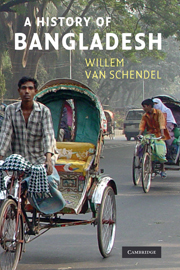Book contents
- Frontmatter
- Contents
- List of plates
- List of maps and figures
- Acknowledgements
- Timeline
- Introduction
- PART I THE LONG VIEW
- 1 A land of water and silt
- 2 Jungle, fields, cities and states
- 3 A region of multiple frontiers
- 4 The delta as a crossroads
- PART II COLONIAL ENCOUNTERS
- PART III BECOMING EAST PAKISTAN
- PART IV WAR AND THE BIRTH OF BANGLADESH
- PART V INDEPENDENT BANGLADESH
- Conclusion
- Bangladesh district maps
- Key political figures since 1947
- Glossary of Bengali terms
- Notes
- Bibliography
- Index
4 - The delta as a crossroads
Published online by Cambridge University Press: 05 February 2015
- Frontmatter
- Contents
- List of plates
- List of maps and figures
- Acknowledgements
- Timeline
- Introduction
- PART I THE LONG VIEW
- 1 A land of water and silt
- 2 Jungle, fields, cities and states
- 3 A region of multiple frontiers
- 4 The delta as a crossroads
- PART II COLONIAL ENCOUNTERS
- PART III BECOMING EAST PAKISTAN
- PART IV WAR AND THE BIRTH OF BANGLADESH
- PART V INDEPENDENT BANGLADESH
- Conclusion
- Bangladesh district maps
- Key political figures since 1947
- Glossary of Bengali terms
- Notes
- Bibliography
- Index
Summary
The population of the Bengal delta has always been remarkably mobile. This has often led to tensions between the territorial rights of sedentary people and the rights of mobile others. These tensions revealed themselves in multiple moving frontiers and a dynamic economy. The Bengal delta was never an isolated place. On the contrary, one of its basic features was its openness to both the immense expanse of the Indian Ocean and an enormous hinterland. For as far back as we can reconstruct, it was integrated into networks of long-distance trade, pilgrimage, political alliance, cultural exchange and travel. It served as a gateway to the wider world for people and goods from the landlocked Ganges plains in the west, from Tibet and Nepal in the north and from the Brahmaputra valley in the east. Conversely, traders, Buddhist pilgrims, political emissaries and adventurers who wanted to visit these regions had to pass through Bengal. It was in the coastal waterways of Bengal that South-east Asians, North Indians, Sri Lankans, Chinese, Arabs, Central Asians, Persians, Ethiopians and Tibetans met from very early times. The geographical reach of this traffic hub was enormous, as can be illustrated by Ibn Battutah's visit in 1346 ce. When this Moroccan traveller left the Maldive Islands south of India, he followed the trade routes via Sri Lanka to the Bengal delta. After spending some time there, he decided to leave and boarded a Chinese junk bound for Java.
- Type
- Chapter
- Information
- A History of Bangladesh , pp. 39 - 46Publisher: Cambridge University PressPrint publication year: 2009



